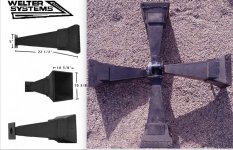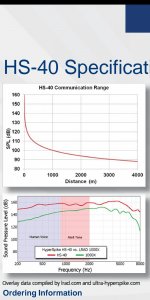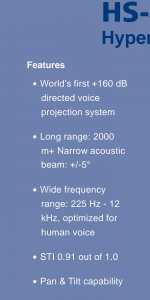If we take a look at a driver datasheet here: Specification
We can see that it specifies a 114dB sensitivity for a 90×75° CD horn. Does this mean that we can get up to 130dB of sensitivity in a narrow horn, like the 13° maltese horn?
The rule of thumb I'm using here is that for every halving of the horn radiation angle, we get a 3dB boost. Because the 13° horn has almost 1/40 the angle, it gets 16dB louder, thus the 130dB sensitivity.
Something is not right here! AFAIK no one has reached this SPL at 1 watt!
We can see that it specifies a 114dB sensitivity for a 90×75° CD horn. Does this mean that we can get up to 130dB of sensitivity in a narrow horn, like the 13° maltese horn?
The rule of thumb I'm using here is that for every halving of the horn radiation angle, we get a 3dB boost. Because the 13° horn has almost 1/40 the angle, it gets 16dB louder, thus the 130dB sensitivity.
Something is not right here! AFAIK no one has reached this SPL at 1 watt!
Nooo... Weltersys' Maltese horn has good specs at a relatively small footprint ( pics below). Also, It's easy to build and doesn't take too much time and stuff... I would love to build something that produces deafening sound levels with just a few milliwatts...
Attachments
Well, a PWT is 0 deg and the driver is 118 dB/mW, so at 1W it's going to be 1000 times more = 118+30 = 148 dB in theory, so 13 deg will be somewhat less as you noted.
GM
This is a typo, it must be 118dB/W.
And another thing- I looked through other BMS products and noticed they have tested their bigger drivers (4599, as an example) using much more narrower 20×40° horns...
If the 4540 could approach 130dB/w.m so easy why BMS didn't publish the amazing numbers as an advertisement?
No I don't think so. This driver gives 114dB through a 90deg horn, 118dB/W is too low for its PWT, IMHO.
If the 4540 could approach 130dB/w.m so easy why BMS didn't publish the amazing numbers as an advertisement?
This is a typo, it must be 118dB/W.
No I don't think so. This driver gives 114dB through a 90deg horn, 118dB/W is too low for its PWT, IMHO.
The horn mouths will only maintain the 13 degree pattern above 7 kHz, at lower frequencies the dispersion will widen.Nooo... Weltersys' Maltese horn has good specs at a relatively small footprint ( pics below). Also, It's easy to build and doesn't take too much time and stuff... I would love to build something that produces deafening sound levels with just a few milliwatts...
The dispersion angle can be approximated by:
angle [deg] = 25400 [m*Hz*deg] / (horn width [m] * frequency [Hz])
Last edited:
Interesting equation! It seems like the iron law for horn directivity but where does the constant number come from? And what about horn length and flare rate? Should I just go simple and assume the radiation angle is the same as horn angle?
And what is this angle exactly? Is it the -3dB angle or the -6dB or... I'm curious because at 2KHz the angle is still under 40° which is pretty impressive.
Also, this reminded me of hailing devices. I now looked among some of them and they were claiming strange specs like 30° directivity at 1KHz with a tiny hand held device. What is going on with them? That is soo far from what this formula suggests. The horn size of theirs sets them off orders of magnitude and exponential flare rates and EQ is of little help at this situation.
HS-10 (Bullhorn / Megaphone Replacement) | HyperSpike(R)
And what is this angle exactly? Is it the -3dB angle or the -6dB or... I'm curious because at 2KHz the angle is still under 40° which is pretty impressive.
Also, this reminded me of hailing devices. I now looked among some of them and they were claiming strange specs like 30° directivity at 1KHz with a tiny hand held device. What is going on with them? That is soo far from what this formula suggests. The horn size of theirs sets them off orders of magnitude and exponential flare rates and EQ is of little help at this situation.
HS-10 (Bullhorn / Megaphone Replacement) | HyperSpike(R)
This is a typo, it must be 118dB/W.
If so, it s a p1$$ poor pile of [your favorite word here] as the ancient W.E./Lansing/Altec/GPA 1" exit drivers can do 144 dB/W on a PWT, 108 dB/W/m on a so-so efficient 90x40 radial horn: http://www.lansingheritage.org/images/altec/specs/components/909-8a-16a/page2.jpg
Then again, if all it can do is an extra 4 dB after the better part of a century's advances in materials, manufacturing technology, maybe it's really not that great after all.
Indeed!A 13 degree horn will be huge.
Interesting equation! It seems like the iron law for horn directivity but where does the constant number come from? And what about horn length and flare rate? Should I just go simple and assume the radiation angle is the same as horn angle?
And what is this angle exactly? Is it the -3dB angle or the -6dB or...
I'm curious because at 2KHz the angle is still under 40° which is pretty impressive.
AFAIK ,it was empirically arrived at. Horn length will depend on throat size, flare frequency. F6: http://www.xlrtechs.com/dbkeele.com...Preprint) - LF Horn Design Using TS Paras.pdf
Yes, if all of the design criteria is met, otherwise it will 'balloon' out.
GM
AFAIK ,it was empirically arrived at. Horn length will depend on throat size, flare frequency. F6: http://www.xlrtechs.com/dbkeele.com...Preprint) - LF Horn Design Using TS Paras.pdf
Hi GM,
You have provided a link to Don's low-frequency horn design paper. The formula in question was actually given in his "What's so Sacred about Exponential Horns?" paper
http://www.xlrtechs.com/dbkeele.com/PDF/Keele (1975-05 AES Preprint) - Whats So Sacred Exp Horns.pdf
Kind regards,
David
If so, it s a p1$$ poor pile of [your favorite word here] as the ancient W.E./Lansing/Altec/GPA 1" exit drivers can do 144 dB/W on a PWT, 108 dB/W/m on a so-so efficient 90x40 radial horn: http://www.lansingheritage.org/images/altec/specs/components/909-8a-16a/page2.jpg
Then again, if all it can do is an extra 4 dB after the better part of a century's advances in materials, manufacturing technology, maybe it's really not that great after all.
GM
Lol 😆 made my day!
Anyway, I'm still in shock. I did a simple calculation and...man! I can get near 130dB with only and only one single tiny watt! It seems like too good to be true?
But the horn is still too long. Hyperspike claims +-15deg dispersion for their smallest products- how on earth is that possible?
You have provided a link to Don's low-frequency horn design paper. The formula in question was actually given in his "What's so Sacred about Exponential Horns?" paper.
Greets!
Yeah, one more strike against my memory
GM
Lol 😆 made my day!
Anyway, I'm still in shock. I did a simple calculation and...man! I can get near 130dB with only and only one single tiny watt! It seems like too good to be true?
But the horn is still too long. Hyperspike claims +-15deg dispersion for their smallest products- how on earth is that possible?
It's really not, but the downside is the size/cost of the mids, LF systems required to keep up with them.
No knowledge of them, but historically such claims are over a narrow BW, like Altec mostly used 500-2500 Hz, the most critical part of the telephone BW.
GM
GM and and LB, why then does BMS mixed statements of xxdB/W and xydB/mW
(but similar numbers) for Plain Wave Tube efficiency in their driver spec sheets ?
How do you explain this 1000x difference ?
Which ones are you referring to? Regardless, probably best to ask them, though I did check one, the 4524, which lists 117 dB/W/m, but click on the download data sht. and it lists 117 dB/mW, so a typo and no doubt any others most likely are too.
GM
Oh I totally forgot about the LF... Near 1000x power to keep up at the certain direction. But I don't need LF. All I need is maximum portability and efficiency to scare friends... And God only knows maybe for the next Halloween I add BMS to itIt's really not, but the downside is the size/cost of the mids, LF systems required to keep up with them.
Right, and I don't think it's the case here as for their larger devices they claim flat response 200Hz to 7KHz at full power! Images belowno knowledge of them, but historically such claims are over a narrow BW, like Altec mostly used 500-2500 Hz, the most critical part of the telephone BW.
GM
Attachments
Sorry, it is Plane Wave Tube ..
Neodymium Compression Drivers
Ferrite Compression Drivers
They only list PWT efficiencies for 1 inch drivers, so apparently they only have a 1 inch PWT at hand.
Of the drivers listed with PWT efficiency in "Specifications" there are 3 with dB/W and 5 with dB/mW.
I did not inspect the individual download sheets. As said, these specs are not without typos.
Which ones are you referring to? Regardless, probably best to ask them, though I did check one, the 4524, which lists 117 dB/W/m, but click on the download data sht. and it lists 117 dB/mW, so a typo and no doubt any others most likely are too.
GM
Neodymium Compression Drivers
Ferrite Compression Drivers
They only list PWT efficiencies for 1 inch drivers, so apparently they only have a 1 inch PWT at hand.
Of the drivers listed with PWT efficiency in "Specifications" there are 3 with dB/W and 5 with dB/mW.
I did not inspect the individual download sheets. As said, these specs are not without typos.
I am not sure what this means.If so, it s a p1$$ poor pile of [your favorite word here] ..
GM
- Status
- This old topic is closed. If you want to reopen this topic, contact a moderator using the "Report Post" button.
- Home
- Loudspeakers
- Multi-Way
- Horn Sensitivity calculation


